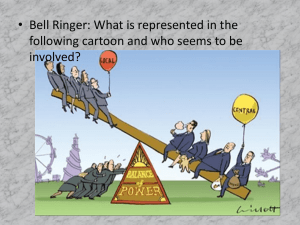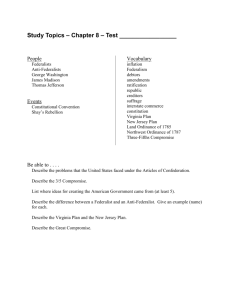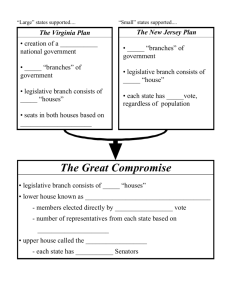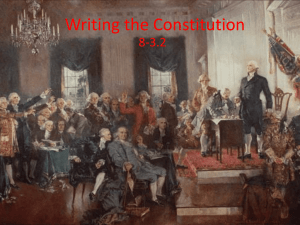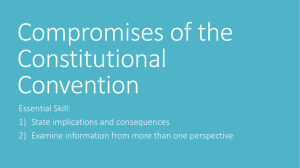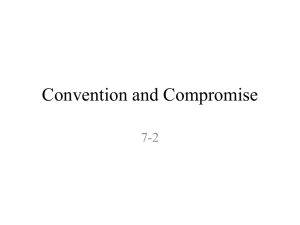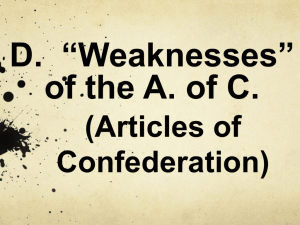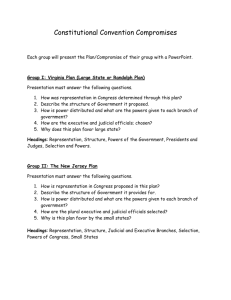Unit Two * Lesson Ten
advertisement
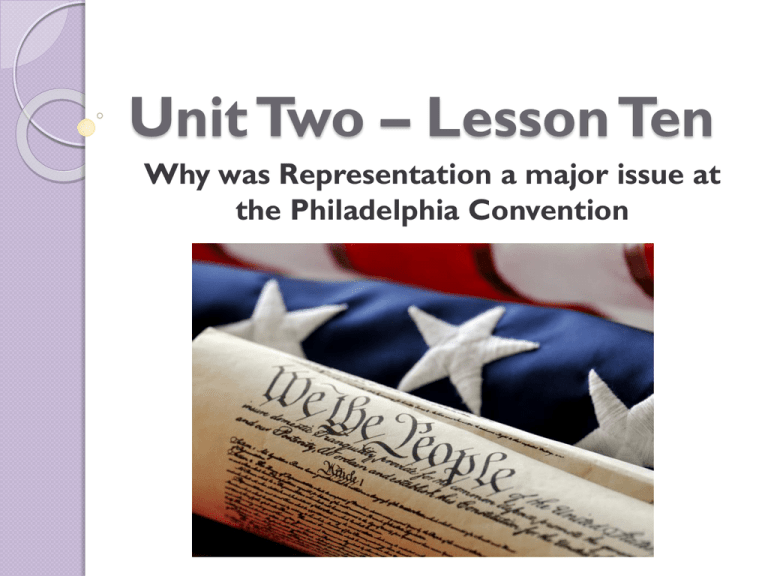
Unit Two – Lesson Ten Why was Representation a major issue at the Philadelphia Convention The New Jersey Plan Congress would be unicameral (like in the A of C) ◦ Power to levy import taxes and a stamp tax to raise money. They also would have to power to compel states to pay. ◦ Power to regulate trade between the states and with other nations ◦ Power to make laws and treaties and no state could make laws contrary to them Executive Branch made up of several people appointed by Congress. They would have power to administer national laws, appoint exec. officials, and direct military operations A Supreme Court would be appointed by the Executive Branch. It would have the power to decide cases involving treaties, trade between states or with other nations, and collection of taxes The national government would represent the states, not the people The Preamble We the people (of the United States) in order to form a more perfect union establish justice, ensure domestic tranquility, provide for the common defense, promote the general welfare and secure the blessing of liberty to ourselves and our posterity, do ordain and establish this constitution for the United States of America Quick Review Name 2 rules of the Philadelphia Convention (AKA Constitutional Convention) The Virginian Plan ◦ How did it favor larger states ◦ What were 3 characteristics of the plan The New Jersey Plan ◦ How did it favor smaller states ◦ What were 3 characteristics of the plan What were the disagreements about Representation? Bicameral was agreed upon – less likely to abuse their power ◦ By Population (j.madison) – believed each vote should count equally. If you have more people, you should have more of a vote/impact. ◦ Equal Representation – the US was a confederation of different states. Each should have an equal say in the Union’s actions. The positions of delegates often based on the size of state they represented. ◦ Big states favored representation based on population ◦ Small states favored equal representation Delegates agreed if Congress was to be bicameral, the House should be based on population. The issue became the Senate Small states came up with an alternate plan Discussion of the plans Virginian Plan ◦ supported by larger states (based on population) ◦ put the power in the hands of qualified elite New Jersey Plan ◦ supported by smaller states (based on equality of states) ◦ put the power in the hands of elected reps Huge debate about who should control the power of the government Failure of either plan to get enough support brought the convention to an impasse A special committee was formed with one delegate from each state James Madison negotiated a compromise between the feuding sides The Great Compromise House of Representatives would be based on population ◦ Power to develop all bills for taxation and government spending The Senate would be equal in representation ◦ 2 Senators per state, appointed by the state legislatures. (this supported the concept that the Senate represented the States not the people) Each side gained a strong-hold in the compromise and gave up a little as well (compromise) The Great Compromise passed on the first vote Other Compromises 3/5ths Compromise ◦ ◦ ◦ ◦ Economic Compromises ◦ ◦ ◦ ◦ Representation: free/slave Southern States/Northern States Property owners/non-owners Census for apportionment every 10 years North – President makes treaties South – Senate must ratify treaties North – Congress can regulate trade South – No duties on trade New States ◦ North/South ◦ East/West ◦ Northwest Ordinance mandated new states on equal Review What were the major arguments about representation in Congress? How did the Virginia and New Jersey Plans differ? What were the key elements of the Great Compromise? How did it address the problems of representation? How did the 3/5ths compromise help settle the dispute about representation? How, if at all, has equal representation in the Senate affected the principle of majority rule?
